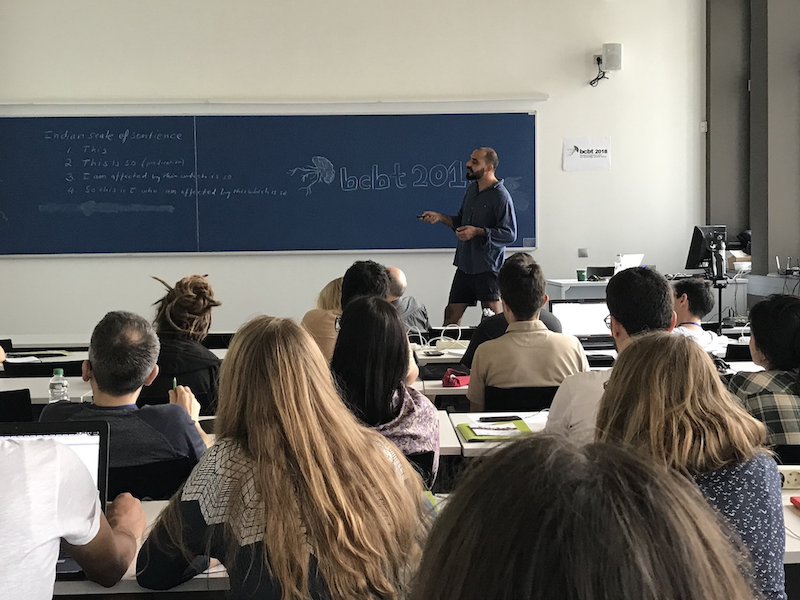DCBT offers hands-on tutorials.
DCBT offers hands-on tutorials.

- State of the art in Brain Architecture: DAC. Adrian Fernandez Amil, Ismael T. Freire (Radboud University, NL)
- Brain Functional Networks Connectivity. BrainX3 & network simulations. Vivek Sharma (Radboud University, NL), Francisco Santos (Eodyne, ES)
- Cell Recording – Processing Pipelines. Alessio Buccino (Allen Institute of Neural Dynamics, US )
- MEG/EEG. Robert Oostenveld (Radboud University, NL)
- TBA
Check the full SCHEDULE
Monday, 05 September 14:00 – 17:00
STATE OF THE ART IN BRAIN ARCHITECTURES. DAC – DISTRIBUTED ADAPTIVE CONTROL.
Adrian Fernandez Amil, Ismael T. Freire Radboud University, NL
This tutorial introduces the Distributed Adaptive Control (DAC), a theory of the design principles underlying the Mind, Brain, Body Nexus (MBBN) that has been developed over the last 20 years. DAC assumes that the brain maintains stability between an embodied agent, its internal state, and its environment through action. It postulates that to act or know-how, the brain has to answer 5 fundamental questions: who, why, what, where, and when. Thus, the function of the brain is to continuously solve the so-called H5W problem, with ‘H’ standing for the ‘How’ an agent acts in the world. The DAC theory is expressed as a neural-based architecture implemented in robots and organized in two complementary structures: layers and columns. The organizational layers are called: reactive, adaptive and contextual, and their columnar organization defines the processing of states of the world, the self, and the generation of action. After an overview of the key elements of DAC, the mapping of its key assumptions toward the invertebrate and mammalian brain is described. The general overview of DAC’s explanation of MBBN is combined with examples of application scenarios in which DAC has been validated, including mobile and humanoid robots, neuro-rehabilitation, and large-scale interactive spaces. In this tutorial, we will provide the elements necessary to implement an autonomous control system based on the DAC architecture, and we will explore how the different layers of DAC contribute to solving a foraging task.
Supported by Eu project: European school of Neuroscience (euSNN) http://www.eusnn.eu/; Virtual Brain Could https://virtualbraincloud-2020.eu; HR-Recycler https://www.hr-recycler.eu/
Tuesday, 06 September 14:00 – 17:00
SPIKE SORTING.
Alessio Buccino Allen Institute of Neural Dynamics, US
MEG/EEG Processing and Analysis with FieldTrip
Robert Oostenveld Radboud University, NL
This tutorial runs over two afternoons (Tue 6 and Wed 7 September).
Part 1.
We will give an introduction to EEG and MEG data, its neuronal generators, and how it is recorded. Subsequently, we will explain how to use the FieldTrip toolbox to analyze the data with different levels of sophistication.
We will also focus on interpreting the EEG and MEG signals. We will do an EEG data acquisition demonstration (you can try it yourself), will look at the typical artifacts to consider in the data, and we will look at preprocessing.
Wednesday, 07 September 14:00 – 17:00
CELL RECORDING – PROCESSING PIPELINES.
Alessio Buccino Allen Institute of Neural Dynamics, US
MEG/EEG Processing and Analysis with FieldTrip
Robert Oostenveld Radboud University, NL
Part 2.
In this part of the tutorial, we will look at the spectral analysis, source reconstruction, measures of connectivity, and network analysis. Both days will comprise a combination of short lectures and hands-on MATLAB exercises on a tutorial dataset.
In the second week of the DCBT school, participants may carry out a short project. We will have time to provide feedback on the projects and to address follow-up questions resulting from the project.
Thursday, 08 September 14:00 – 17:00
LARGE-SCALE MODELLING OF BRAIN ACTIVITY
Francisco Santos Eodyne, ES
Since the advent of connectomics, large-scale modeling of the human brain has proved to be a valuable tool for unraveling the mechanisms of brain activity and the emergence of functional networks. In this tutorial, we will explore the basics of large-scale modeling of brain dynamics and how it can be used to study functional networks in health and disease. We will start by defining the mean-field dynamics of single neural populations using differential equations, and then explore the interaction between excitatory and inhibitory neural masses. Then, we will start building up toward long-range interactions between populations of excitatory and inhibitory neurons and how to use healthy structural connectivity data to constrain our models in order to model functional connectivity networks. Finally, we will compare the functional connectivity of models before and after simulated structural lesions.
BRAIN DATA VISUALIZATION WITH BRAINX3
Vivek Sharma Radboud University, NL
With this tutorial, we address multi-modal data integration in human brain imaging using BrainX3, an interactive platform for 3D visualization, analysis, and simulation of human neuroimaging data. We will focus on volumetric MRI data, DTI/DSI tractographic data, intracranial epilepsy data, and semantic corpora from available text databases. BrainX3 provides a tool to organize and visualize data and extract meaningful insights about brain structures and functional networks. BrainX3 is a useful tool for scientific exploration and in the clinic to investigate complex neuro-pathologies and for neuro-surgery. BrainX3 is developed by the SPECS research group to advance knowledge in mind-brain and behaviour.
Supported by Eu projects: European school of Neuroscience (euSNN) http://www.eusnn.eu/ and Virtual Brain Could https://virtualbraincloud-2020.eu
Friday, 09 September 14:00 – 15:00
TALK: BRINGING NEUROTECHNOLOGY TO THE PUBLIC
Santiago Brandi Eodyne, ES
